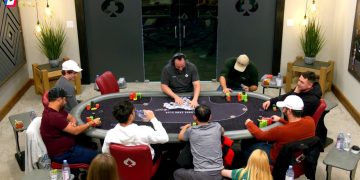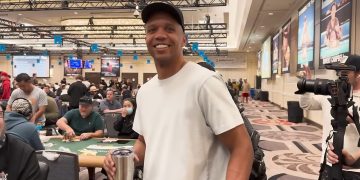Welcome to your Game Theory Optimal roller coaster ride. Will that roller coaster stop at the top, bottom, or somewhere in between?
A lot of poker players love to throw around the phrase, “GTO Poker”. The reason they do this is simple: It makes them sound smarter than they actually are. If they’re truly playing GTO poker, they’re not letting anyone else know about it because other players would exploit them.
That brings us to the next topic, as well as a very important topic within this article: Is Game Theory Optimal more effective than exploitative poker in poker tournaments? Hmm… That’s all I’m going to say right now (Hmm…). You will see what I mean by the time you’re done reading.
What Is Game Theory Optimal Poker?

GTO stands for Game Theory Optimal, which means you’re playing the optimal poker strategy, or the best strategy possible. This is very math-oriented as well as self-focused. You’re doing what you’re supposed to do based on the cards, pot sizes, stack sizes, poker position, etc. While this might sound highly effective, it’s also the problem.
Game Theory Optimal doesn’t take into account the opposing player’s tendencies. This is a massive problem for GTO poker. If you’re following Game Theory Optimal and it says that you should put out a big bluff on the river vs. your opponent, it’s not taking into consideration the possibility that your opponent is a calling station. This can also be a problem on the other end of the spectrum.
If Game Theory Optimal says that you should bet big for max value on the river, what if your opponent is passive and only plays the nuts? His range of poker hands might be narrower than the stream in your backyard (sometimes you can’t even see it). You would want to decrease your bet in order to get paid in that spot.
Game Theory Optimal is great in theory, but poker tournaments are too dynamic to succeed with a black and white poker strategy. It just doesn’t work that way. Pretty much nothing in the world works that way. You need to have maneuverability in anything you do to succeed.
I just read an article defending GTO poker. Then I went to the source and looked up the writer who wrote the article. My earnings aren’t terrific because I was a cash game player for years, and Coconut Creek doesn’t report all poker tournaments, where I had three wins (actual wins) in one week, but this guy has been playing tournaments for five more years than me and has half the amount of earnings. I cannot trust that source. But don’t take it from me, take it from poker pros who have accomplished much more than me.
I watched a video where the interviewer asked nine poker pros if they played Game Theory Optimal. Here were their replies:
Faraz Jaka: “Not very much.”
Mustapha Kanit: “Zero.”
Luke Schwartz: “Pretty GTO in Omaha. Not that GTO in hold’em.”
Randy Lew: “Not GTO.”
Fedor Holz: “Just the basics, but mostly feel and flow.”
Jason Mercier: “Not very GTO.”
Celina Lin Pei Fei: “It changes.”
Andreas Hoivold: “Not at all.”
Bryn Kenney: “No. I play gangster style.”
Do those replies hit home at all? If not, here are their earnings:
Faraz Jaka
Total Live Earnings: $6,469,146
Best Live Cash: $774,780
Mustapha Kanit
Total Live Earnings: $11,486,708
Best Live Cash: $1,653,491
Luke Schwartz
Total Live Earnings: $1,761,111
Best Live Cash: $406,736
Randy Lew
Total Earnings
Total Live Earnings: $1,596,647
Best Live Cash: $484,617
Fedor Holz
Total Live Earnings: $32,556,377
Best Live Cash: $6,000,000
Jason Mercier
Total Live Earnings: $18,856,362
Best Live Cash: $1,622,181
Celina Lin Pei Fei
Total Live Earnings: $1,018,901
Best Live Cash: $110,077
Andreas Hoivold
Total Live Earnings: $1,883,211
Best Live Cash: $880,572
Bryn Kenney
Total Live Earnings: $34,942,306
Best Live Cash: $3,062,513
Game Theory Optimal vs. Exploitative Poker

Exploitative poker simply means that you’re exploiting the weaknesses of your opponents. This is completely within the poker rules and not dirty at all. Every poker player has different weaknesses, and with this strategy, your job is to exploit each weakness for each player. Let’s go with a few examples.
Example #1: The player directly to your left has played three hands in three hours. If he was wearing an undershirt, it might have a huge S on it for Super NIT. Since you will be in the Small Blind when he’s in the Big Blind, you will likely have many opportunities to steal the Big Blind from him. It depends on how the table is playing, but this will usually be the case.
The only potential problem is if the person you’re exploiting begins to detect that you’re exploiting them. At that point, he will begin to stand up for himself, which will allow you to back down. The bigger threat is if your opponent is crafty. If he recognizes that you’re exploiting him and he’s crafty, he will continue to play the passive role while having a plan of attack in mind. This is how deep poker games and poker thinking can get.
When you attempt to exploit poker players, you open the door for them to exploit you. This is within the poker rules for them as well, and it’s not dirty, so you can’t get upset. For instance, if you continue to check-raise, that usually valuable weapon is going to begin to look weaker.
Your opponent might come over the top at the exact time you need to score that check-raise-bluff. In a more general and bigger-picture sense, by using an exploitative style of play, you are opening up several defense walls that were previously made of concrete. You don’t want to be a NIT, but you do want to appear as a NIT so you can take advantage of your opponents.
Do you pick up on that? The key is to be exploitative without anyone ever having an idea you’re doing it because you’re doing it on the defensive side. This keeps you out of dangerous pots.
Remember, the pot is a dangerous place to be in Texas Hold’em poker tournaments. By taking this approach, your defensive walls will remain concrete, but what makes these walls unique is that you can bend them. This means you’re not a NIT, a maniac, a GTO player, or a traditionally exploitative player. Instead, you’re something people rarely encounter: a deceptively exploitative poker player.
Use this approach in all poker games and watch your earnings rapidly increase. You won’t win every time. Nobody does. In order to maintain emotional control, always look at the big picture. Just finished my poker year, which I run from August-August. I was on the + side, which is nice, but it’s not nearly as high as it was earlier in the year. I must remind myself that if someone asked me prior to last August: “If you would end up at this number at the end of the year, would you take it?” My answer would be, “Yes.”
This also applies to cash game sessions. You rarely finish at your peak. Let’s say you were up $802 three hours ago and now you’re only up $345 and about to leave. If you’re like most poker players, you’re going to be upset about this, but always put yourself in the same spot I mentioned above. If someone asked you prior to the cash game session: “If you could finish this session at +$345, would you take it?” The answer would likely be, “Yes.” You need to focus on where you finish, not your peak.
Example #2: You are in Seat 2 and there is a player in Seat 9 who continuously raises your Big Blind. It’s beginning to get on your nerves, but you have remained patient. Eventually, you take a stand and re-raise pre-flop with 6d 3d. You are proud of yourself because YOU WON”T BE BULLIED! Sorry, buddy, but that’s ego talking. He jams on you and now you have to fold, wasting valuable chips.
The correct way to play this is to set the trap. Keep folding those minuscule blinds and antes (BB ante is in almost all Texas hold’em poker tournaments now). The more you fold, the more you draw him in.
If you have been patient and you finally see a premium hand when the blinds and antes are higher, you’re going to collect more chips off him in one hand than he did off you in any previous hand. If he calls, excellent, you’re in the Big Blind.
Therefore, since you raised from the Big Blind, you can represent an A, K, Q as well as any low cards that hit the flop because it could indicate that you got fed up with his raises and finally took a stand with low cards. He will also put you on the possibility of a flopped set if you bet out against him when you’re out of position.
No matter what, you’re going to take down this pot most of the time. Why? Because you were patient and deceptively exploited his exploitative tendencies. All the while, he thought he was winning, and you let him think that in order set him up for this spot. Not only that, since he’s likely to fold, you can pull it off again at some point over the next few orbits.
If this opponent eventually sees what you have been up to (if you have to show your cards), he’s going to be dumbfounded, but it’s best that he never sees your cards. You never know when you might see him again in poker tournaments down the road.
Example #3: This is a completely different type of situation and relates to reading physical tells. If you watch carefully, there will always be someone who gives away physical tells. It could be the guy in Seat 6 who always twitches his nose when he has a monster, or the lady in Seat 3 who smiles wide when she’s bluffing, or it could be the guy in Seat 8 who shakes his leg relentlessly whenever he’s on a draw. It’s his body’s way of telling him he’s excited about potentially winning money. If he has the nuts, he will also probably shake his leg. If he’s bluffing, everything will go still.
This is the most reliable kind of exploit because they can’t exploit you back—they don’t realize that you’re picking up on their physical tells. This is an incredibly powerful tool. Not only are your opponents telling you the answers with their betting patterns, how they handle their chips, any by what they say, they’re also telling you the answers by their body movements.
Final Thoughts
It should be obvious by now that Game Theory Optimal is not the way to go in poker tournaments. GTO poker forces you to play your poker hands in robotic ways, which is not going to lead to long-term success.
Whether you want to believe it or not, you don’t need GTO poker. You also don’t need exploitative poker. The truth is that you already know the answer in at least 90% of situations. It’s just a matter of truly listening to yourself or not. This isn’t some kind of self-help mumbo-jumbo. This is reality.
I say you already know the answer because if you play poker then you have seen the same patterns over and over again. Your brain recognizes these patterns. If you can keep emotion completely out of it, then you will have the reputation of incredible reading ability. I’m going to assume you want that reputation.
I’d like to make one more point on exploitative poker before signing off. While it might be better than Game Theory Optimal, it’s also not optimal. Playing the traditional form of exploitative poker would be like starting a war, firing all your weapons for maximum impact, but not protecting your borders because you’re assuming you’re going to wipe out your enemy without any retaliation.
This is not how you win a war. You win a war by getting your enemy to believe they’re the stronger force, luring them to a battlefield that makes them highly susceptible, and attacking with precision. See you at the WSOP!
♠ pokerjournal.org
Game Theory Optimal – FAQ
What does GTO stand for in poker?
GTO stands for game theory optimal.
What is game theory optimal poker?
It supposedly means that you're making the correct decision every time, which prevents your opponent from exploiting you, but the game is too dynamic in the real world for this to be effective.
Should I play GTO poker?
If you want to look like a robot, which will make you predictable, yes. If you want to play the player, then no.
Does a game theory optimal strategy really work?
I don't believe it does. It doesn't factor in everything you need to know about your opponents.


















Discussion about this post